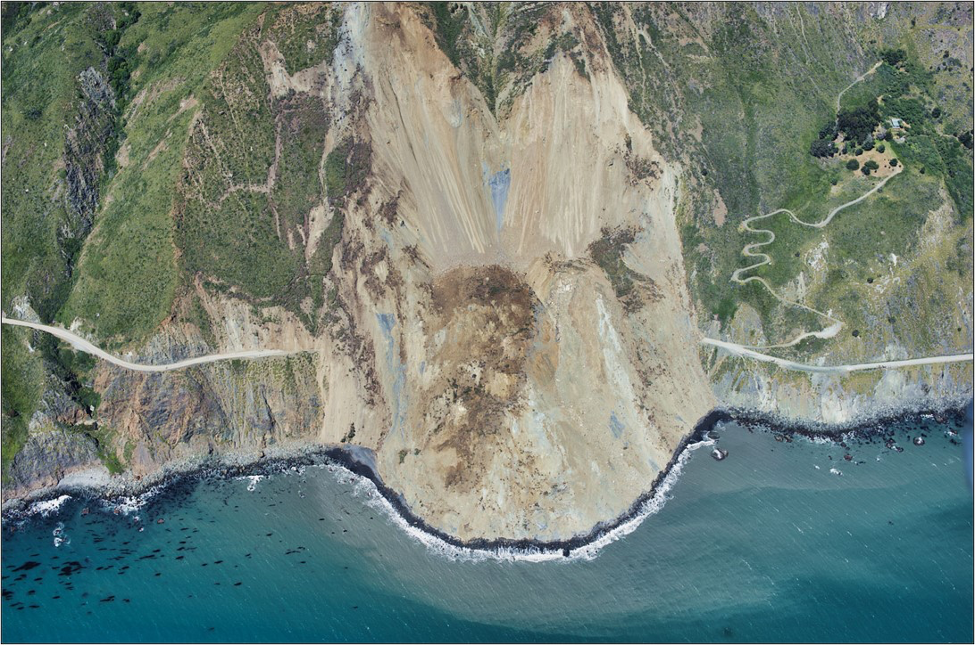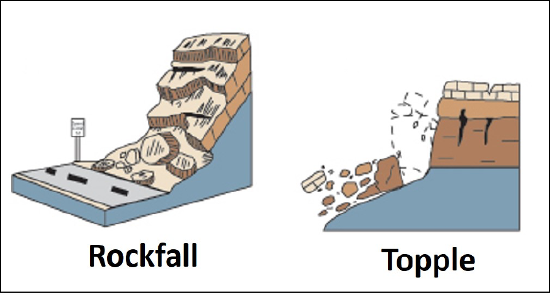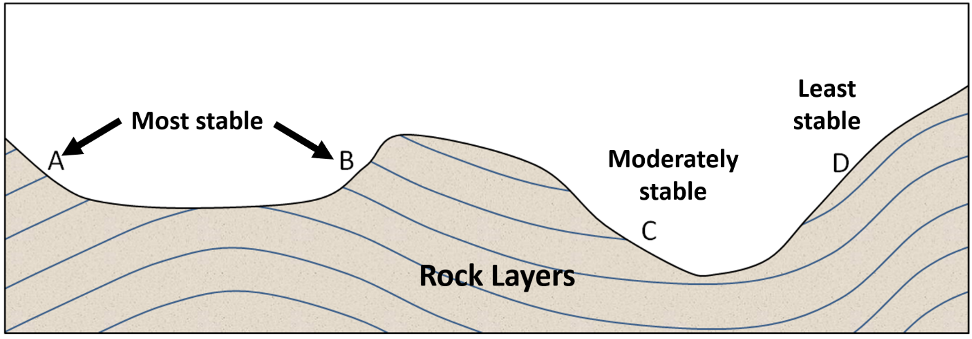10.1: Front Matter
- Page ID
- 14561
What Is Mass Wasting?
Mass wasting is the downhill movement of rock and soil material due to gravity. The term landslide is often used as a synonym, but mass wasting is a much broader term referring to all movement downslope. Movement by mass wasting can be slow or rapid. Rapid movement can be dangerous, such as during debris flows. Recall that erosion is a powerful and continuous process and therefore landslides can be devastating and costly. In California, we have many regions with a high potential for landslides, particularly if you live near the coast, mountains, or a recent burn area (Figure 10.1).

Those who study mass wasting are typically referred to as geomorphologists or hazard scientists. Like many other geoscientists, working with other disciplines is common, with a heavy influence from both math and technology. Many are employed by universities where they teach and/or do research, and state and federal agencies, including geological surveys, like the California Geological Survey or United State Geological Survey (USGS). Additional career pathways are available in the private sector including hazard mitigation and assessment. Many of these career options require a college degree and postgraduate work. If you are interested, talk to your geology instructor for advice. We recommend completing as many math and science courses as possible (chemistry is incredibly important for mineralogy). Also, visit National Parks, CA State Parks, museums, gem & mineral shows, or join a local rock and mineral club. Typically, natural history museums will have wonderful displays of rocks, including those from your local region. Here in California, there are a number of large collections, including the San Diego Natural History Museum, Natural History Museum of Los Angeles County, Santa Barbara Museum of Natural History, and Kimball Natural History Museum. Many colleges and universities also have their own collections/museums.
Mass Wasting Categories
Mass wasting can be subdivided by type of movement (falls, flows and slides), the overall geologic material (bedrock, debris, or earth) (Table 10.1), and the average rate of movement (Table 10.2). Mass wasting types often share common morphological features observed on the surface: head scarps commonly seen as crescent shapes on a cliff face; hummocky or uneven surfaces; accumulations of talus (loose rocky material falling from above); and toe of slope, which covers existing surface material.
| Category of Movement | Subcategory of Movement | Material | Speed |
|---|---|---|---|
| Falls | Rock Fall | Rock | Extremely rapid |
| Rock/Block Avalanche | Rock | Very rapid | |
| Topple | Rock, soil, debris | Extremely rapid | |
| Flows | Debris flow | Rock, soil, debris, water | Extremely rapid to rapid |
| Mud flow | Soil (mud & silt), water | Extremely rapid to rapid | |
| Earth flow | Soil and debris | Moderate to slow | |
| Creep | Soil | Extremely slow | |
| Slides | Translational slide | Rock, soli, debris | Extremely rapid to very slow |
| Rotational slide | Soil and debris | Extremely slow to moderate |
| Approximate Rates of Movement for Mass Wasting | |
|---|---|
| Extremely rapid to very rapid | 3 m (10 ft) per second |
| Rapid | 0.3 (1 ft) per minute |
| Moderate | 1.5 m (5 ft) per day |
| Slow | 1.5 (5 ft) per month |
| Very slow: | 1.5 (5 ft) per year |
| Extremely slow | 0.3 m (1 ft) per 5 years |
Falls
Falls are abrupt movements of masses of geologic materials, such as rocks and boulders, that become detached from steep slopes or cliffs (Figure 10.2). Separation occurs along natural breaks, like fractures, joints, and bedding planes, and movement occurs by free-fall, bouncing, and rolling. Falls are strongly influenced by gravity, mechanical weathering, and water. Yosemite National Park is well known for its impressive rock falls.

| Mass Wasting: Falls | |||
|---|---|---|---|
| Category of Movement | Subcategory of Movement | Material | Speed |
| Falls | Rock Fall | Rock | Extremely rapid |
| Debris/Earth Fall | Rock, soil, debris | Very rapid | |
| Topple | Rock, soil, debris | Extremely rapid | |
Flows
Flows are rapidly moving mass wasting events in which the loose material is typically mixed with abundant water, creating long run outs at the slope base (Figure 10.3). Depending on the type of material involved and the amount of water, flows can be separated into debris flow (coarse material), mudflow (fine material, faster), and earthflow (fine material, slower). Creep is the imperceptibly slow downward movement of material caused by a regular cycle of nighttime freezing followed by daytime thawing in unconsolidated material such as soil. During the freeze, expansion of ice pushes soil particles out away from the slope, while the next day following the thaw, gravity pulls them directly downward. The net effect is a gradual movement of surface soil particles downhill. Creep is indicated by curved tree trunks, bent fences or retaining walls, tilted poles or fences, and small soil ripples or ridges. A special type of soil creep is solifluction, which is the slow movement of soil lobes on low-angle slopes due to soil seasonally freezing and thawing in high-latitude, typically sub-Arctic, Arctic, and Antarctic locations.

| Category of Movement | Subcategory of Movement | Material | Speed |
|---|---|---|---|
| Flows | Debris flow | Rock, soil, debris, water | Extremely rapid to rapid |
| Mudflow | Soil (mud & silt), water | Extremely rapid to rapid | |
| Earthflow | Soil and debris | Moderate to slow | |
| Creep | Soil | Extremely slow |
Slides
A translational slide is rock, soil or debris that moves as a block(s) along a sloping surface, similar to sliding down a playground slide (Figure 10.4, right). In most cases, the movement occurs along a plane of weakness and may run parallel to a fracture, bedding, or metamorphic foliation plane. Rotational slides (or slumps) commonly show slow movement along a curved rupture surface (Figure 10.4, left).

| Mass Wasting: Slides | |||
|---|---|---|---|
| Category of Movement | Subcategory of Movement | Material | Speed |
| Slide | Translational slide | Rock, soil, debris | Extremely rapid to very slow |
| Rotational (slump) | Soil and debris | Extremely slow to moderate | |
Resisting vs. Driving Forces
Slope movement occurs when forces pulling down-slope (mainly gravity) exceed the strength and inertia of the earth materials that compose the slope. Mass wasting can be initiated on slopes already on the verge of movement by rainfall, snowmelt, changes in water level, stream erosion, changes in groundwater, earthquakes, volcanic activity, disturbance by human activities, or any combination of these factors.
The steepest angle at which rock and soil material is stable and will not move downslope is called the angle of repose, which is measured relative from the horizontal. When a slope is at its angle of repose, the shear force of gravity is in equilibrium with the normal force. If the slope becomes just slightly steeper, the shear force exceeds the normal force, and the material starts to move downhill. The angle of repose varies for all material and slopes depending on many factors, such as grain size, grain composition, and water content. In general, if the total shear force acting on the earth materials exceeds the total normal force acting on the earth materials, the slope will become unstable and a landslide is likely (Figure 10.5).

There are several contributing factors that increase the effects of down-slope forces and weaken the cohesion of slope materials, thereby increasing the chance of a mass wasting. Some of these contributing factors can be prevented by human mitigation, while others we are unable to change.
Geology
The overall strength and composition of the rock, orientation of bedding, or foliation planes are all important contributing factors. For example, a bed oriented in the same direction as the slope is more likely to fail than bedding going against the slope (Figure 10.6).

Water
Slope saturation is a primary cause of mass wasting. A small amount of water helps to hold grains of sand or soil together; for example, you can build a larger sand castle with slightly wet sand than with dry sand. Too much water, however, causes the sand to flow away quickly. Rapid snow melt or rainfall adds extra water to the soil, which increases the weight of the slope and makes sediment grains lose contact with each other, encouraging flow.
Landslides and flooding are closely allied because both are related to precipitation, runoff, and the saturation of ground by water. In addition, debris flows and mudflows usually occur in small, steep stream channels and often are mistaken for floods; in fact, these two events often occur simultaneously in the same area.
Vegetation
Tree roots, grasses, and other indigenous vegetation can help bind soil together and prevent motion. After a wildfire has ravaged a slope, it is vulnerable to mass wasting and flash flooding during heavy precipitation events.
Undercutting
The process of undercutting occurs naturally along coastlines and river bank; it involves running water or waves removing material from the base of the slope, but not at the top, thereby increasing the slope’s angle and the likelihood of slope failure. Undercutting is particularly dangerous when the underlying rock layers slope towards the area.
Ground shaking
An earthquake, volcanic eruption, or even just a truck driving by can shake unstable ground loose and cause a slide. The occurrence of earthquakes in steep landslide-prone areas greatly increases the likelihood that landslides will occur, due to ground shaking alone or liquefaction. For example, during the 1994 Northridge earthquake, more than 11,000 landslides were triggered in the immediate area (10,000 km2). In volcanic regions, lahars and general slope failures are possible. In some cases, submarine landslides occur, which may induce tsunami waves.
Human Impacts
Humans can contribute to mass wasting in a number of different ways. When an area is under construction, the overall slope must be considered. Construction planners need to consider drainage, loading (addition of weight), undercutting, removal of vegetation, and ground shaking. If the slope becomes compromised, the slope will need to be stabilized before moving forward with construction; however, stabilization does not always prevent future landslides.
Prevention and Awareness
Vulnerability to landslide hazards is a function of location, type of human activity, use, and frequency of landslide events. The effects of landslides on people and structures can be lessened by total avoidance of landslide hazard areas or by restricting, prohibiting, or imposing conditions on hazard-zone activity. In some areas, it is necessary to establish warning systems so that we know if conditions have changed at a known slide area, or if a rapid failure, such as a debris flow, is actually on its way downslope. Local governments can reduce landslide effects through land-use policies and regulations. Individuals can reduce their exposure to hazards by educating themselves on the past hazard history of a site and by making inquiries to planning and engineering departments of local governments. They can also obtain the professional services of an engineering geologist, a geotechnical engineer, or a civil engineer, who can properly evaluate the hazard potential of a site, built or unbuilt. It is important to remember that our efforts to “prevent” mass wasting are only as good as our resolve to maintain those preventive measures. For more landslide preparedness visit the USGS Landslide Preparedness page.
Attributions
- Figure 10.1: “Big Sur Landslide on May 20, 2017” (Public Domain; USGS)
- Table 10.1: “Mass Wasting Categories” (CC-BY 4.0; Chloe Branciforte, own work)
- Table 10.2: “Approximate Rates of Movement for Mass Wasting” (CC-BY 4.0; Chloe Branciforte, own work)
- Figure 10.2: Derivative of “Landslide Types and Processes” (Public Domain; USGS) by Chloe Branciforte
- Table 10.3: “Mass Wasting: Falls” (CC-BY 4.0; Chloe Branciforte, own work)
- Figure 10.3: Derivative of “Landslide Types and Processes” (Public Domain; USGS) by Chloe Branciforte
- Table 10.4: “Mass Wasting: Flows” (CC-BY 4.0; Chloe Branciforte, own work)
- Figure 10.5: Derivative of “Landslide Types and Processes” (Public Domain; USGS) by Chloe Branciforte
- Table 10.5: “Mass Wasting: Slides” (CC-BY 4.0; Chloe Branciforte, own work)
- Figure 10.5: Derivative of “Forces on a Block on an Inclined Plane” (CC-BY-SA-NC 4.0; Paul Inkenbrandt via Open Geology) by Chloe Branciforte
- Figure 10.6: Derivative of “Slope Stability and Orientation” (CC-BY 4.0; Steven Earle via OpenText) by Chloe Branciforte


